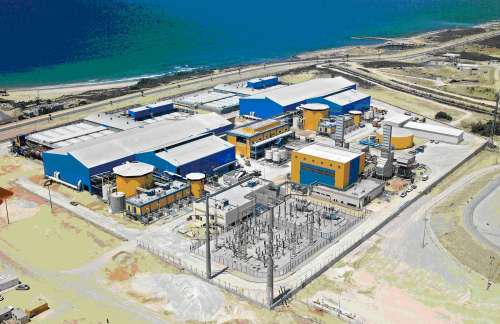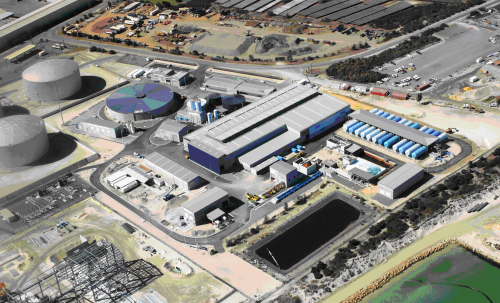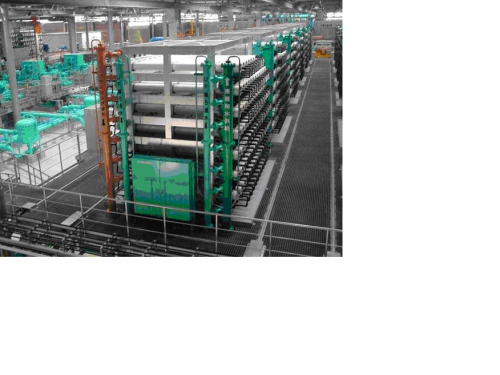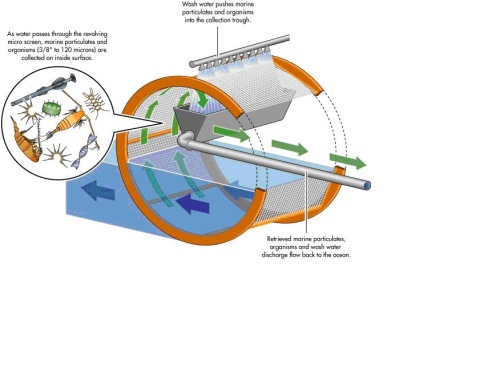



Introduction
Seawater pre-treatment is an integral part of every seawater reverse osmosis (SWRO) desalination plant. Ideally, after pre-treatment the only solids left in the seawater would be the dissolved minerals and as long as the seawater system is operated in a manner that prevents minerals from precipitating on the membrane surface, the SWRO membranes could operate without any cleaning for a very long time.
In actuality, however, pre-treatment systems remove most but not all of the suspended solids contained in the source seawater and so are prone to fouling by the suspended solids, particulates and silt that remain in the seawater after pre-treatment. Fouling can be reverted by periodic cleaning of the SWRO, however in some cases, membrane fouling could be irreversible and cleaning may not recover productivity, which may require the replacement of some or all of the SWRO membranes.
Two types of pre-treatment systems are typically used to protect the SWRO membranes from fouling: conventional granular media filtration and membrane filtration. Currently, conventional granular media filtration is the predominant pre-treatment technology for large and medium size desalination plants. Conventional seawater pre-treatment filters have configuration and media similar to these used in fresh water filtration applications and could be either gravity or pressure-driven filters. Gravity pre-treatment filters have been used for some of the largest SWRO desalination plants in the world in operation today such as the 325,000 m³/day Ashkelon plant in Israel (see Figure 1).
Pressure granular media filters, for example, are used for the 160,000 m³/day plant in Perth, Australia (see Figure 2). Pressure filters are also widely used in small plants worldwide because they are cost-competitive, space efficient and easier and faster to install and operate when compared to granular media gravity filters. Often when the source seawater is collected via open intake, two-stage dual media (sand and anthracite) pressure filters are applied. One of the key cost disadvantages of these filters is that they operate under pressure and therefore use more energy than gravity filters.
The application of membrane filtration for seawater pre-treatment is relatively new. At present, less than a half-a-dozen full-scale seawater desalination plants worldwide are using membrane pre-treatment. These pre-treatment systems apply ultrafiltration (UF) or microfiltration (MF) membranes installed in modules through which source seawater is filtered using either pressure or vacuum.
The largest full-scale seawater membrane pre-treatment system in the world is located at the 140,000 m³/day SWRO plant in Addur, Bahrain. This plant, as well as the largest membrane pre-treatment system in Asia, located at the 96,000 m³/day Fukuoka desalination plant in Japan (see Figure 3), use pressure-driven UF membranes for seawater pre-treatment.
To date, UF membranes have found wider application for seawater pre-treatment than MF membranes mainly because they typically provide better removal of suspended organics, silt and pathogens from the source seawater. Often silt particulates contained in seawater have a size similar to that of the pore openings of MF membranes, which means suspended silt particles in the source seawater may lodge into the MF membrane pores during the process and may cause irreversible fouling. Since UF membrane pores are significantly smaller than these of the MF membranes, typically they do not face this problem.
The selection of filtration technology for seawater pre-treatment should be based on a thorough life-cycle cost-benefit analysis. Side-by-side pilot testing of the two types of systems is also highly recommended to develop background system performance information for objective selection. The following issues should be taken into consideration when selecting between granular media and membrane pre-treatment filtration.
Effect of source seawater quality
Micro- and ultrafiltration have a wider spectrum of particle removal capabilities than conventional media filtration. Single or dual-medial filters usually have lesser removal efficiency in terms of raw water organics in suspended form, disinfection byproduct precursors, fine particles, silt and pathogens. Membrane filtration technologies are also less prone to upsets caused by seasonal changes in source seawater temperature, pH, turbidity, colour, pathogen contamination, and size and type of water particles, because their primary treatment mechanism is a mechanical particle removal through fine-pore membranes.
Therefore, for applications where intake water quality experiences significant seasonal variations and presents a challenge in terms of high pathogen, fine particles and elevated particulate organics contamination, membrane filtration technologies are likely to offer performance benefits. However, if the source water for the desalination plant is collected from an open intake located far from the surf zone and at adequate depth to be exposed to only limited seasonal variations (typically 20 metres or deeper), granular media filtration may offer a very cost-effective pre-treatment alternative to membrane filtration.
Source seawater temperature is a very important factor when selecting a pre-treatment system. Application of vacuum driven membrane pre-treatment systems is usually less cost-effective than pressure membrane filtration and conventional granular media filtration for seawater of temperature lower than 12 ºC, because the productivity (flux) of vacuum-driven membrane filtration is dramatically reduced by the significant increase in unit weight of seawater at low temperature.
Sand media filtration may have certain additional benefits for a seawater source that is very likely to be exposed to sudden and unpredictable changes of water quality such as: very high or low pH chemical spills; large oil and grease spills; frequent exposures to very high water temperature, or other contaminants that may damage the MF or UF pre-treatment membranes irreversibly, if they are used for this application. Typically, granular filter media can handle a wider range of the extreme intake water quality conditions and the cost of media replacement is significantly lower than that for replacing all membrane elements for the same size plant.
This issue is of a very significant importance for pre-treatment systems for seawater desalination plants with surface intakes. Often the source seawater contains small sharp objects (such as shell particles), which can easily puncture the pre-treatment membranes and result in a very quick loss of their integrity, unless the damaging particles are removed upstream of the membrane pre-treatment system by incorporating a microscreening system of screen mesh size of 120-micron or less ahead of the membrane pre-treatment system (see Figure 4).
In addition, seawater contains barnacles, which in their embryonic phase of development are 130 to 150 microns in size and can pass the screen openings unless they are 120 microns or smaller. Once barnacles establish colonies in the pre-treatment facilities and equipment, they are very difficult to remove and can withstand chlorination, which is otherwise very effective biocide for most other marine organisms. The use of fine micro-screens (80 to 120-micron size) is essential for reliable operation of the entire seawater desalination plant using membrane pre-treatment and therefore its cost has to be taken under consideration when comparing conventional and membrane filtration pre-treatment. Micro-screens are not needed for pre-treatment systems using granular media filtration because these systems effectively remove barnacles in all phases of their development.
If membrane pre-treatment is selected for desalination plants with open ocean intakes prone to frequent and extensive red tides or algal blooms, the use of dissolved air flotation (DAF) or granular media filtration system ahead of the membrane pre-treatment facility is highly recommended.
Footprint
Membrane technologies are more space-efficient as compared to granular media filtration. The smaller footprint benefits of membrane filtration are usually of greater importance when upgrading existing water treatment plants of limited site area availability or where the cost of new land acquisition is significant.
Depending on the type and size of the membrane modules and the intake water quality characteristics, the membrane filtration system may have 20 to 60 percent smaller footprint than a conventional filtration system. The space benefits of membrane filtration are more significant for high-turbidity seawater where two-stage granular media filtration may be required to achieve comparable performance to a single stage membrane pre-treatment system. For a more difficult to treat intake seawater, which requires the granular media filtration system to be designed for surface loading rates of less than 4.0 gpm/sq ft (10 m³/m².hr), or where two-stage granular media filtration is needed to produce comparable filter effluent, the membrane filtration systems may have up to 60 percent smaller footprint.
As a rule of thumb, under typical surface-water quality conditions, the footprint of granular media filters, designed at a surface loading rate of 3.5 to 5.0 gpm/sq ft (8.5 to 12.2 m³/m².hr), is approximately 30 to 50 percent larger than that of an ultra or micro-filtration systems producing similar filtered water quality. For better-than-average influent water quality where granular media filters can perform adequately at surface loading rates of 6 to 8 gpm/sq ft (15 to 20 m³/m².hr) of hydraulic surface loading rate, the total footprint difference is usually 20 to 40 percent in the benefit of membrane pre-treatment.
Waste stream quantity and quality
Conventional and membrane pre-treatment systems differ significantly by the type, quality and amount of the generated waste streams. Typically, conventional media filtration systems generate only one waste stream – waste filter backwash. The volume of this stream in a well designed plant varies between 4 to 6 % of the total plant intake source water volume. In addition to the solids that were originally in the source water, this waste stream also contains coagulant (typically iron salt) and polymer.
Membrane pre-treatment systems typically generate two large waste streams: waste membrane wash water and membrane cleaning solution. The volume of the membrane wash water stream is typically 8 to 12 % of the plant intake source volume – i.e. approximately twice as large as the waste filter backwash generated by conventional systems. The waste stream difference is even larger, taking into account that the microscreens required to be installed to protect the pre-treatment membrane filters will generate additional waste discharge for their cleaning.. The relatively larger waste stream volume of the membrane pre-treatment system would require proportionally larger intake source volume, which in turn would result in increased size and construction costs for the desalination plant intake facilities and higher operation, and maintenance costs for source water pumping to the pre-treatment facilities.
In addition to daily membrane washing and monthly membrane cleaning, cost competitive design and operation of membrane pre-treatment systems often requires short daily chemically enhanced membrane backwash (CEB) using high dosage of chlorine and base and acid over a short period of time. This performance enhancing CEB also adds to the volume of the waste streams generated at the RO membrane plant and to the overall cost of source water pre-treatment.
Chemical use
Typically, conventional granular media pre-treatment systems use source water conditioning chemicals for effective solids separation. This adds to the plant chemical costs. However, they do not use any chemicals for media cleaning (outside of occasional addition of chlorine). The membrane pre-treatment systems use significant amounts of membrane cleaning chemicals, which may be comparable in total annual cost to the source water conditioning chemicals used by the conventional granular media filters. The cost of these cleaning chemicals has to be considered in the cost-benefit analysis of the plant pre-treatment system.
Another factor that has to be accounted for in the overall plant chemical use and cost analysis is that the RO system cleaning frequency, and therefore the SWRO membrane cleaning costs, may be reduced by using membrane pre-treatment due to the typically better solids and silt removal capabilities of this type of pre-treatment.
Power use
Conventional pre-treatment systems use limited amount of power to separate particulates in the source water. As mentioned previously, large SWRO desalination plants typically include gravity granular filtration pre-treatment process which has minimum power requirements. On the other hand, depending on the type of the membrane system (pressure or vacuum-driven) the membrane systems use approximately two times more power to remove particulates from the source water as compared to gravity granular media filters. More power is not only used to create a flow-driving pressure through the membranes, but also for membrane backwash and source seawater pumping. The total power use has to be taken into consideration when completing a life-cycle cost comparison of conventional versus membrane pre-treatment system for a given application.
Frequency of filtration media replacement
Well operating granular media filters lose 5 to 10 % of filter media per year, which has to be replaced to maintain consistent performance. The costs of granular media replacement are usually well predictable and relatively low.At present, membrane element useful life typically varies in a range of 3 to 5 years. Assuming 5 years of useful life, in average approximately 20 percent of the membrane elements would need to be replaced per year to maintain system production capacity and performance.
An additional factor that may contribute to the need for more frequent replacement of membrane elements is the failure of membrane element integrity. In fact, a recent study of existing membrane systems in the US and worldwide indicates that in most or the surveyed installations, the main reason triggering the need for early membrane element replacement was the loss of integrity rather than the loss of production capacity. The limited track record of long-term use of membrane systems and the uncertainty related to the factors triggering the need for their replacement have to be taken under consideration when selecting between granular media and membrane pre-treatment technology for RO plants. The risk of loss of membrane integrity has to be handled accordingly in the membrane element useful life warranty provided by the membrane manufacturer/supplier.
Taking under consideration that the annual costs for replacement of pre-treatment membranes are usually comparable to the annual expenditures for replacement of the SWRO membranes they are installed to protect, the large expenditures for replacement of pre-treatment membranes often render this type of pre-treatment technology less attractive than conventional granular media pre-treatment. Although theoretically, the use of membrane pre-treatment instead of granular filtration should reduce the frequency of SWRO membrane cleaning and replacement, because of the lack of full-scale track record to prove this assumption, at present most SWRO membrane suppliers are reluctant to provide guarantees for longer useful life or cleaning cycles for their seawater membrane products. As a result, the potential benefit of membrane pre-treatment cannot be easily accounted for in an actual cost-benefit analysis for full-scale seawater desalination projects.
Diversity of membrane elements and configurations
Currently, all UF and MF membrane manufacturers offer their own design, size and configuration of membrane elements and systems. The membrane systems differ by the type of filtration driving force (pressure or vacuum); the size of the individual membrane elements; the size of the membrane vessels; the configuration of the membrane modules; the type of membrane element backwash; and the type of membrane integrity testing method.
The lack of product uniformity and commoditization in the membrane market today is a sign of a fast-growing field of the water equipment industry and carries benefits and disadvantages.The availability of multiple membrane suppliers and systems allows to better accommodate the site-specific needs of a given membrane application, thereby increasing the use of membrane systems for water treatment. In addition, the lack of commoditization of the MF and UF membrane market along with the increase in membrane applications in recent years, spurs the interest of many manufacturers which traditionally do not produce membranes to enter the membrane market with new products. This in turn, results in increased competition and in accelerated development of new membrane technologies and equipment.
Although a new top-of-the-line membrane treatment system that has unique features may yield appreciable near-term construction and operation cost savings, these savings may be compromised over the useful life of the project, which is typically 30 years or more, if the system design is not flexible enough to accommodate the benefits of future membrane technologies. As well as this, the potential threat of membrane manufacturers cancellation of their product must be considered, and the resultant downtime and expense accrued by replacing membranes and renovating a plant to be suitable for a new product that this would entail.
Based on the current status and diversity of the micro and ultrafiltration technologies, a sound approach towards reducing risks associated with the funding and implementation of a membrane system is to design the system configuration in such a manner that is would accommodate the replacement of this system/membrane elements with at least one other existing system/membrane elements of similar type. The additional construction and installation cost expenditures to provide flexible membrane system configuration that allows future membrane system modifications and use of alternative suppliers of the same type of membrane elements at minimal expenditure or replacement, are very likely to be compensated by lowering the funding costs (costs of capital) for the project and by minimizing the overall life-cycle costs of the membrane plant.
Life-cycle costs
At present, the cost of production of desalinated water using membrane pre-treatment is typically 5 to 10 % higher than that for fresh water produced by desalination plants with conventional seawater pre-treatment. In some cases, such as conditions when the cost and availability of land are at premium and/or unit chemical costs and energy are relatively low, membrane pre-treatment may be more cost advantageous.
Key factors that are often underestimated or omitted when comparing conventional and membrane pre-treatment systems are: (1) the additional capital and O&M costs of the micro-screening system needed to protect the pre-treatment membranes; (2) the actual chemical costs and frequency of pre-treatment membrane cleaning and chemically enhanced backwash; (3) the useful life and replacement costs of the pre-treatment membranes – most analyses assume 5 years while actual operational data shows that membranes need to be replaced in approximately 3 years due to loss of integrity; (4) erroneous assumption that the SWRO membrane manufacturers will guarantee lower RO membrane replacement and cleaning frequencies if membrane pre-treatment is used; (5) the higher cost of project financing associated with the use of membrane pre-treatment because of the long-term risk associated with the use of technology of limited full-scale track record, especially for large-scale installations.
Summary and conclusions
Membrane seawater pre-treatment is an attractive alternative to conventional granular media filtration. However, taking under consideration the numerous factors affecting the pre-treatment costs of a full-scale seawater desalination plant, the selection of the most suitable pre-treatment system for a given seawater desalination project has to be completed based on a thorough life-cycle cost analysis which accounts for all expenditures and actual costs associated with the installation and operation of the two systems.
As the desalination industry gains long-term experience with the operation of seawater membrane pre-treatment systems in the next five to ten years and the existing membrane pre-treatment technologies evolve and converge into compatible, standardized and commoditized products, the use UF or MF membranes for seawater pre-treatment is expected to become more competitive and attractive over time. Meanwhile, expect for circumstantially driven conditions favouring the use of UF or MF membrane pre-treatment conventional granular media filtration is anticipated to continue to dominate seawater applications in the near future.






